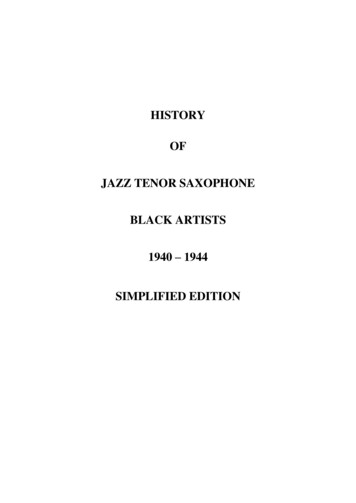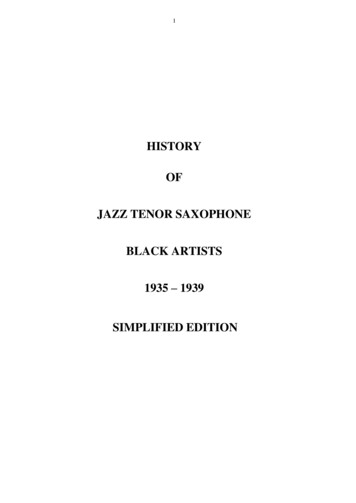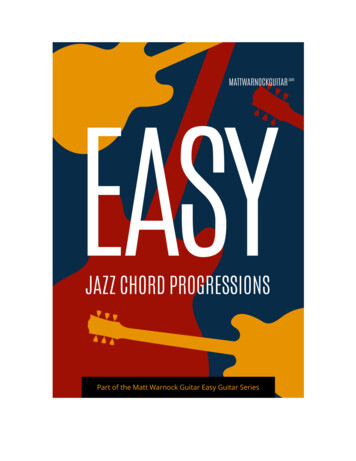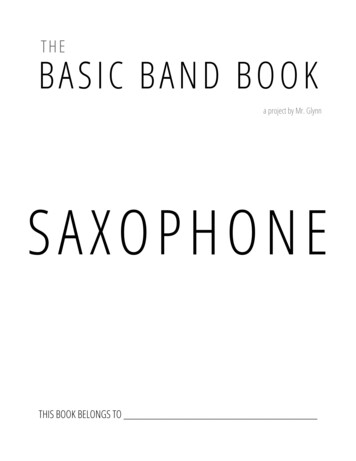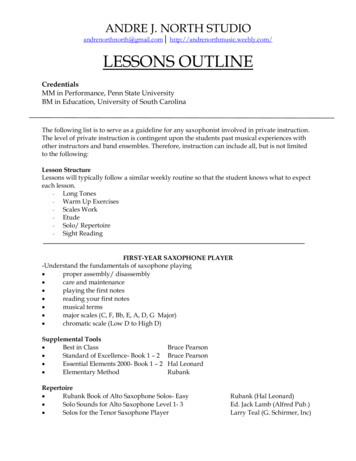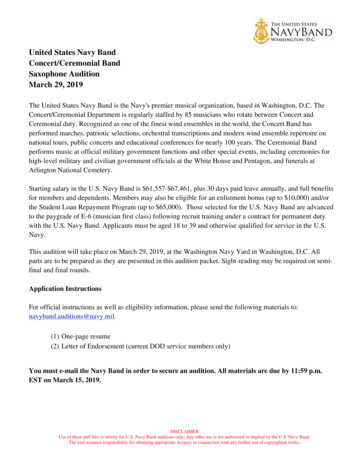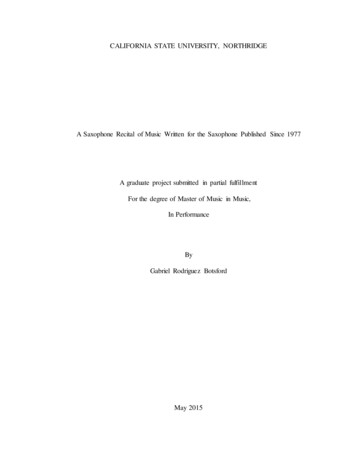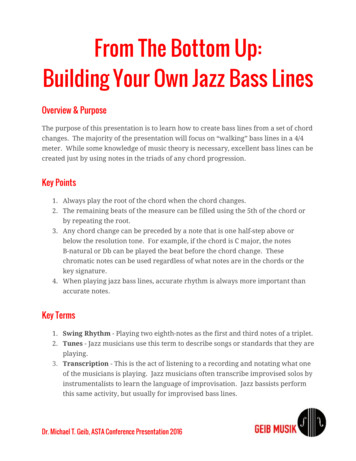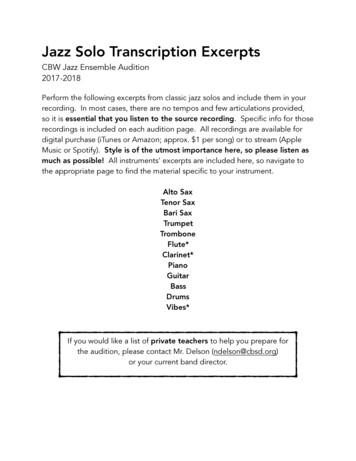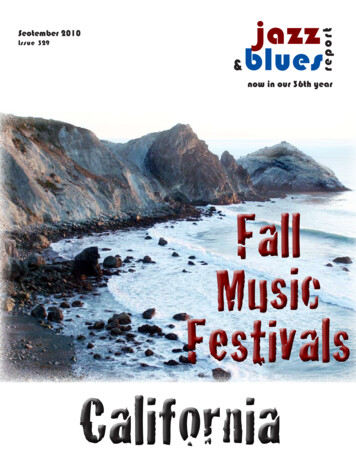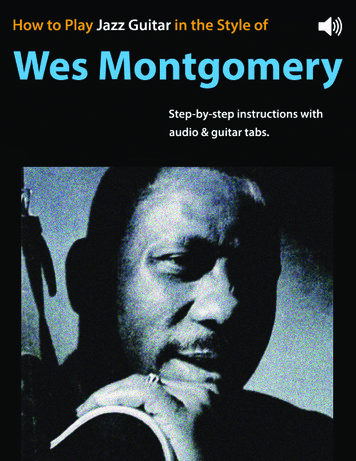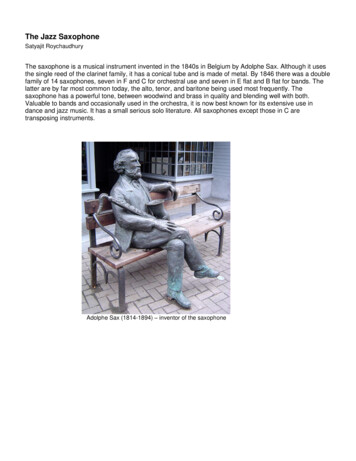
Transcription
The Jazz SaxophoneSatyajit RoychaudhuryThe saxophone is a musical instrument invented in the 1840s in Belgium by Adolphe Sax. Although it usesthe single reed of the clarinet family, it has a conical tube and is made of metal. By 1846 there was a doublefamily of 14 saxophones, seven in F and C for orchestral use and seven in E flat and B flat for bands. Thelatter are by far most common today, the alto, tenor, and baritone being used most frequently. Thesaxophone has a powerful tone, between woodwind and brass in quality and blending well with both.Valuable to bands and occasionally used in the orchestra, it is now best known for its extensive use indance and jazz music. It has a small serious solo literature. All saxophones except those in C aretransposing instruments.Adolphe Sax (1814-1894) – inventor of the saxophone
The Saxophone Timeline (1814 – 2002)1814 - Antoine-Joseph (Adolphe) Sax born 6 November, Dinant, Belgium, studies instrument-making with his father,Charles-Joseph.1834 - Adolphe Sax perfects bass-clarinet design; *improves keywork and construction1842 - Sax arrives in Paris1842 - 12 June--Sax's close friend Hector Berlioz writes article in Paris magazine Journal des Debats describing Sax'snewest invention--the saxophone1844 - 3 February--Berlioz conducts concert which features an arrangement of his choral work Chant Sacre whichincludes saxophone1844 - December--Saxophone makes its orchestral debut in Georges Kastner's opera Last King of Juda; ParisConservatory1846 - Sax granted patent for saxophone1894 - Sax dies1911 - Tom Brown and the Brown Brothers saxophone sextet popularize saxophone with American public withrecordings of such songs as: Bullfrog Blues, Chicken Walk, et.al.1922 - Saxophone used in Mussorgsky/Ravel Pictures at an Exhibition1923 - Rhapsody in Blue by George Gershwin (2 altos, tenor)1927 - Ravel uses saxophone in his Bolero (sopranissimo, soprano, tenor)1928 - An American in Paris by George Gershwin (alto, tenor, bari)1928 - Symphony No. 1 Aaron Copland (alto)1949 - Jazz saxophonists Gerry Mulligan and Lee Konitz feature, along with other artists, on Miles Davis' album Birth ofthe Cool1954 - The Selmer Mark VI Saxophone begins to be produced1955 - Charlie "Bird" Parker dies in New York City on March 121957 - Saxophone Colossus released by jazz tenor man Sonny Rollins1958 - John Coltrane is jazz tenor saxophonist and quartet leader on the album, Giant Steps1959 - Jazz tenor legend Lester Young dies in New York on March 151963 - The Art of Saxophone Playing is published by Larry Teal1964 - John Coltrane's A Love Supreme issued1967 - Coltrane dies, July 171969 - May 19, Coleman Hawkins dies1969 - December - 1st World Saxophone Congress Meeting, Chicago; organized by1970 - 2nd World Saxophone Congress Meeting, Chicago1971 - 3rd WSC Meeting in Toronto1973 - Fourth WSC Meeting in Bordeaux, France1975 - Cannonball Adderly dies1976 - Mark VII introduced with standard high F# key1976 - Selmer's square-chamber mouthpieces marketed1977 - 30 May, Desmond dies1981 - Selmer S80 introduced1982 - 7th WSC in Nuremburg, Germany1986 - Selmer S80 Series II introduced1991 - Stan Getz dies1996- Gerry MulligandiesThe SaxophoneMasters1997 - 11th World Saxophone Congress in Italy1997 - Chris Potter wins Jazz Par Prize1997 - Joshua Redman wins Thelonious Monk Competition1998 - William Albright dies1999 - Branford Marsalis releases Requiem2000 - 12th World Saxophone Congress in Montreal, Ontario, CANADA2001 - Joe Henderson dies2002 - Nick Brignola dies2002 - America's Tribute to Adolphe Sax, Vols. 1-7 is released in box set. (AUR)
The Saxophone FamilySeattle musician Jay C. Easton with 10 members of the saxophone family (from largest to smallest: contrabass, bass,baritone, tenor, C tenor, alto, F mezzo-soprano, soprano, C soprano, sopranino). Photo by Adrienne Easton.Reproduced from the Jay C. Easton official website with the kind permission of Jay Easton (www.jayeaston.com)Alto Saxophone in Eb and it’s rangeTenor Saxophone in Bb and it’s rangeThe alto and the tenor saxophones are the two most popular saxophones used in jazz.
The Masters of Jazz SaxophoneJimmy Dorsey1904–57, and his brother Tommy Dorsey (Thomas Francis Dorsey, Jr.), 1905–1956, both b. Shenandoah, Pa., American jazz musicians and bandleadersduring the Big Band era. Jimmy Dorsey played the clarinet and alto saxophone,his brother the trombone. Toward the beginning of their careers in the late1920s both were part of the Paul Whiteman Orchestra, and by the early 1930sboth were successful pick-up and studio musicians. The two briefly had twobands together, the swing group of 1933–35 and another from 1953–56. Mostof the time, however, each had his own band—Jimmy's a dance-oriented groupand Tommy's more of a hot and sweet jazz ensemble that for awhile (1939–42)featured Frank Sinatra. The Dorsey bands were popular during the Big Bandera (late 1930s to early 50s). Dorsey bands were featured in several Hollywoodmovies, and the brothers starred in a fictionalized film biography, The FabulousDorseys (1947).Coleman Hawkins1904–69, American jazz musician, b. St. Joseph, Mo. He began playing saxophoneat the age of 9. He was part of Fletcher Henderson 's band from 1924 until 1934.Hawkins established the tenor saxophone as a major jazz instrument. His enormoustone, vigorous attack, and improvisatory genius both in ballads and up-tempo piecesmade his influence pervasive. Because his style constantly evolved, Hawkins wasdistinguished even in the company of avant-garde jazz musicians from 1945 until1969.
Lester Young1909–59, American jazz musician, b. Woodville, Miss. He played the tenor saxophone withvarious bands (1929–40), including those of Fletcher Henderson and Count Basie, withwhom he first recorded in 1936. Young and Coleman Hawkins are considered the majorinfluences on tenor-saxophone playing, and Young's style was important in thedevelopment of progressive, or cool, jazz, which arose in the late 1940s. He won severaljazz polls and made a number of records, including a series with Billie Holiday, who gavehim his nickname, "President," later shortened to "Pres" or "Prez." ―Goodbye Porkpie Hat‖waswritten by Charlie Mingus in his memory after Lester Young passed away.Charlie “Bird” Parker1920–55, American musician and composer, b. Kansas City, Kans. He began playing altosaxophone in 1933, and after shifting from one band to another he met Dizzy Gillespie inNew York City. They formed a quintet, which in 1945 made the first bop (or bebop)records and thus became the leaders of the bop movement in jazz. Parker's brilliantimprovisations, noted for their power and beauty, soon earned the admiration ofinnumerable musicians. He composed several instrumental quartets and made manyrecordings. For many years Parker was addicted to drugs, which hastened his death.
John Coltrane1926–67, American jazz musician, b. Hamlet, N.C. He began playing tenorsaxophone as an adolescent. Coltrane worked with numerous big bands beforeemerging in the mid-1950s as a major stylist while playing as a sideman with MilesDavis. Originally influenced by Lester Young, Coltrane displayed in his playing adazzling technical brilliance combined with ardent emotion and eventually a kind ofmysticism. His style, which was at once sonorous and spare, was influenced by therhythms of African and Asian music. Coltrane made a number of influentialrecordings, among them the modal-jazz classics My Favorite Things (1961) and ALove Supreme (1964), and the later exemplars of free jazz, Ascension andInterstellar Space, his final album. From the late 1950s until his death he wasconsidered the outstanding tenor and soprano saxophonist of the jazz avant-garde,and his music continues to be a strong source of inspiration to contemporary jazzand pop musician.Stan Getz1927–91, American jazz tenor saxophonist, b.Philadelphia, Pa., as Stanley Gayetsky. As a maturemusician he was especially known for his "cool" jazzstyle. He began playing as a teenager in JackTeagarden's band, later appearing with bandleadinggreats Stan Kenton, Jimmy Dorsey, Benny Goodman,and Woody Herman. His early playing was heavilyinfluenced by Lester Young, and he recorded a numberof singles with the likes of Dizzy Gillespie and GerryMulligan. During the 1960s Getz experimented with theBrazilian bossa nova sound, which was particularlysuited to his breathy style and resulted in such hitrecords as "Desafinado" and "The Girl from Ipanema."His later work continued to be improvisational,expressive, emotional, and highly melodic, but with asomewhat harder edge.
Ornette Coleman1930–, African-American saxophonist and composer, b. Fort Worth, Tex. Largely selftaught, he began playing the alto saxophone in rhythm-and-blues bands. He laterdeveloped an unorthodox and impassioned style of free jazz characterized by brokenrhythms, atonal harmonies, and improvised melody, which made him an enduringlycontroversial figure in the jazz avant-garde. Coleman made his first real impact in thecommercial jazz world in 1959 and has since played in a number of small groups withvarious musicians. In the mid-1970s he formed the Prime Time band. Coleman haswritten several modernist concert pieces, notably the orchestral Skies of America(1972).Sonny Rollins1930- , American jazz tenor saxophonist, b. September 7, 1930 in New York City. SonnyRollins has had a long, productive career in jazz, beginning his career at the age of 11and playing with Thelonious Monk before reaching the age of 20. Rollins is still touringand recording today, having outlived several of his contemporaries such as JohnColtrane, Miles Davis. He was first recorded in 1949 began to make a name for himselfby recording with Miles Davis and Thelonious Monk. Rollins' most widely acclaimedalbum ―Saxophone Colossus‖ was recorded in 1956. In 1957 he also pioneered the useof just bass and drums as accompaniment for his saxophone solos, a texture that cameto be known as "strolling". He is well-known as a composer; and compositions such as"St. Thomas", "Doxy", "Oleo" and "Airegin" have become standards. By 1959, Rollinstook his first sabbatical. Upon his return he named his "comeback" album ―The Bridge‖.Throughout the '60s Rollins remained one of the most adventurous musicians. Eachalbum he recorded differed radically from the previous one. He also provided thesoundtrack to the 1966 version of Alfie. Rollins took his second sabbatical to study yoga,meditation, and Eastern philosophies. His bands throughout the '70s and '80s featuredelectric guitar, electric bass, and funk-oriented drummers. Rollins’ most famousappearance to rock music fans was his appearance on the 1981 Rolling Stones album―Tattoo You‖ in which he plays saxophone several tracks. Although his recordings in the'70s, '80s, and '90s were not as critically acclaimed as his earlier recordings, hecontinues to be known for his powerful live performances. On September 11, 2001,Rollins, who lived several blocks away, heard the World Trade Center collapse, and wasforced to evacuate his apartment, with only his saxophone in hand. Although he wasshaken, he traveled Boston five days later, to play at Berklee College. That concert was released on CD in 2005,'Without a Song:The 9/11 Concert.Rollins was presented with a Grammy Award for lifetime achievement in 2004.After a highly successful Japanesetour in late 2005, Rollins returned to the recording studio for the first time in five years to record, "Sonny, Please." At the same time,he launched his own website, and started his own label, Doxy Records.The city of Minneapolis, MN officially named TuesdayOctober 31st, 2006 after him in honor of his achievements and contributions to the world of Jazz.
Wayne Shorter1933 - ,American jazz composer and saxophonist, b. in Newark, NJ. In 1956 Shorterplayed briefly with Horace Silver and Maynard Ferguson. In 1959 Shorter joined ArtBlakey and the Jazz Messengers. He stayed with Blakey for five years, and eventuallybecame musical director for the group. In 1964, Miles Davis persuaded Shorter to jointhe Miles Davis Quintet alongside Herbie Hancock, Ron Carter and Tony Williams. Davischse him to replace John Coltrane. Shorter composed extensively for Davis ("Prince ofDarkness", "ESP", "Footprints" etc). Herbie Hancock said: "The master writer to me, inthat group, was Wayne Shorter. He still is a master.‖ Davis said: "Wayne is a realcomposer. He writes scores, writes the parts for everybody just as he wants them tosound. He also brought in a kind of curiosity about working with musical rules.‖ Whilewith Miles Davis, Shorter recorded several albums, featuring almost exclusively his owncompositions. JuJu and Speak No Evil are two of the most well known recordings. Healso recorded occasionally as a sideman with Donald Byrd, McCoy Tyner, FreddieHubbard, Lee Morgan, and bandmates Hancock and Williams. In 1969 he played thesoprano saxophone on the Davis album In a Silent Way and on his own Super Nova. Bythe early 1970s, however, he chiefly played soprano saxophone. Shorter remained inDavis's band after the breakup of the quintet in 1968, playing on early jazz fusionrecordings including In a Silent Way and Bitches Brew (both 1969). His last live datesand studio recordings with Davis were in 1970. In 1970, along with keyboardist JoeZawinul formed Weather Report. A great variety of excellent musicians that would makeup Weather Report alumnus over the years (most notably the revolutionary bassist JacoPastorius). Shorter also recorded critically acclaimed albums as leader, notably NativeDancer, which featured Brazilian composer and vocalist Milton Nascimento. Concurrently, in the late 1970s and the early 1980s hetoured in the V.S.O.P. quintet. This group was a revival of the 1960s Miles Davis quintet, with Freddie Hubbard playing trumpet.After leaving Weather Report, Shorter continued to record and lead groups in jazz fusion styles. He contniued to work with HerbieHancock, in
The saxophone is a musical instrument invented in the 1840s in Belgium by Adolphe Sax. Although it uses the single reed of the clarinet family, it has a conical tube and is made of metal. By 1846 there was a double family of 14 saxophones, seven in F and C for orchestral use and seven in E flat and B flat for bands. The latter are by far most common today, the alto, tenor, and baritone being .
